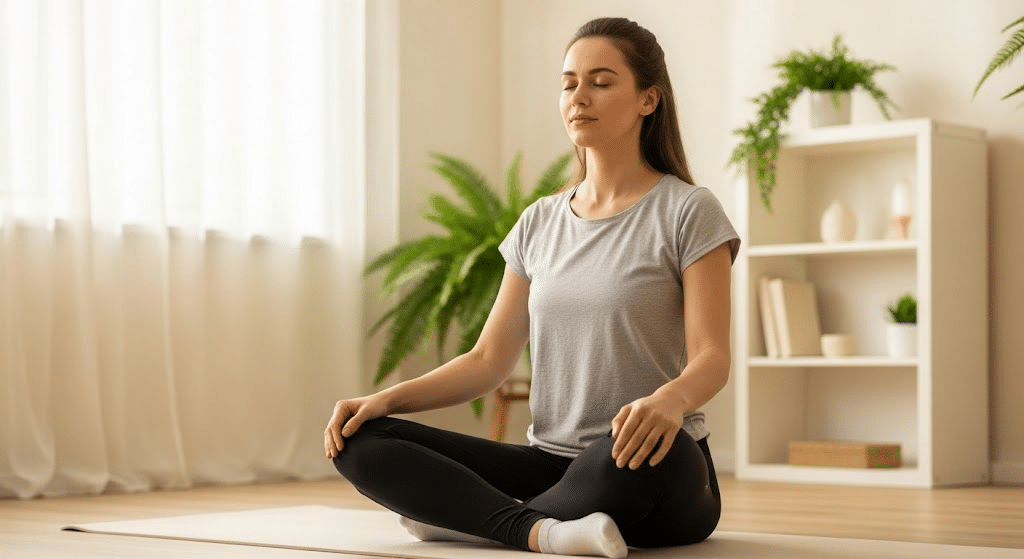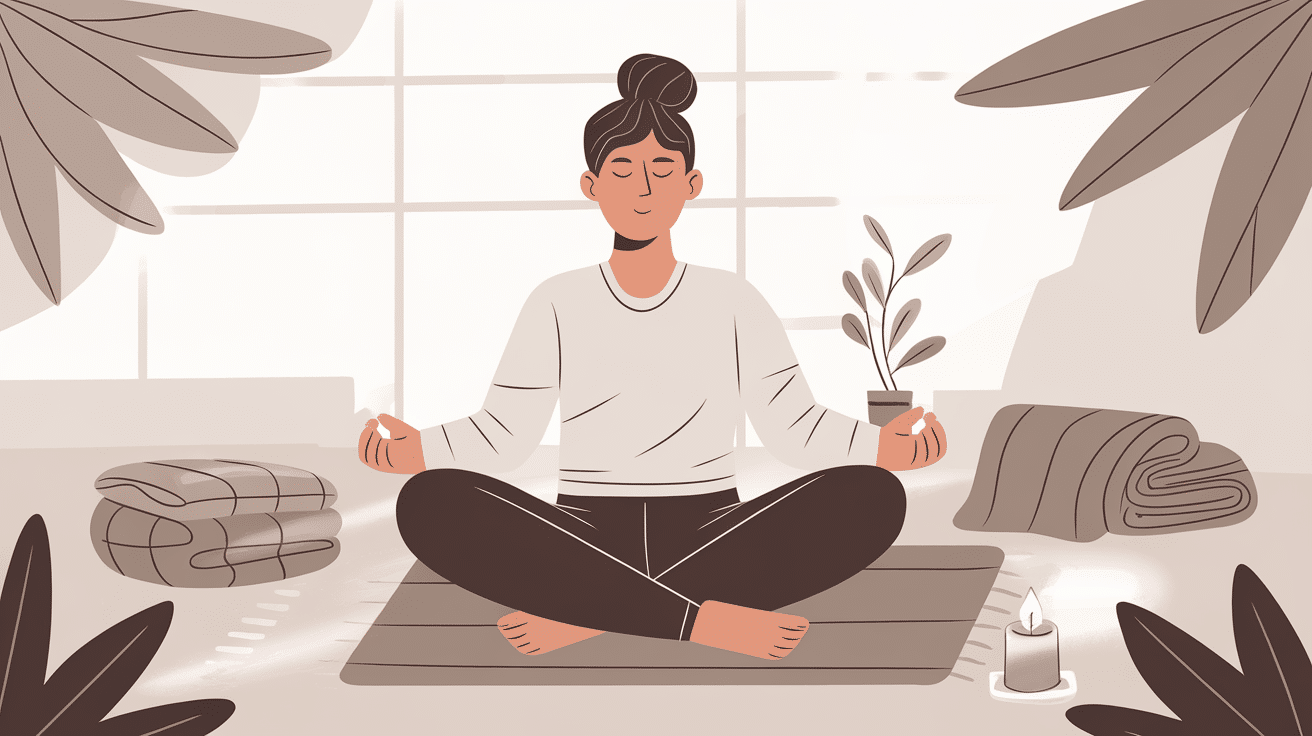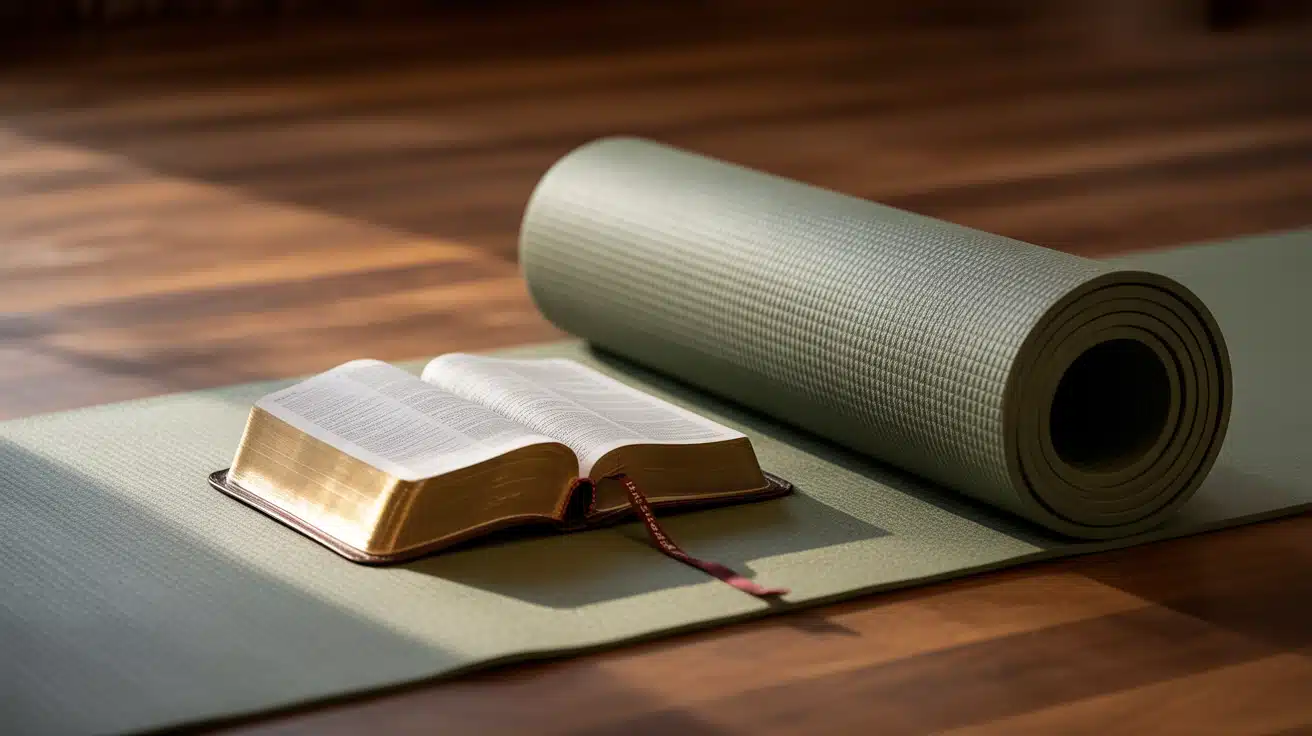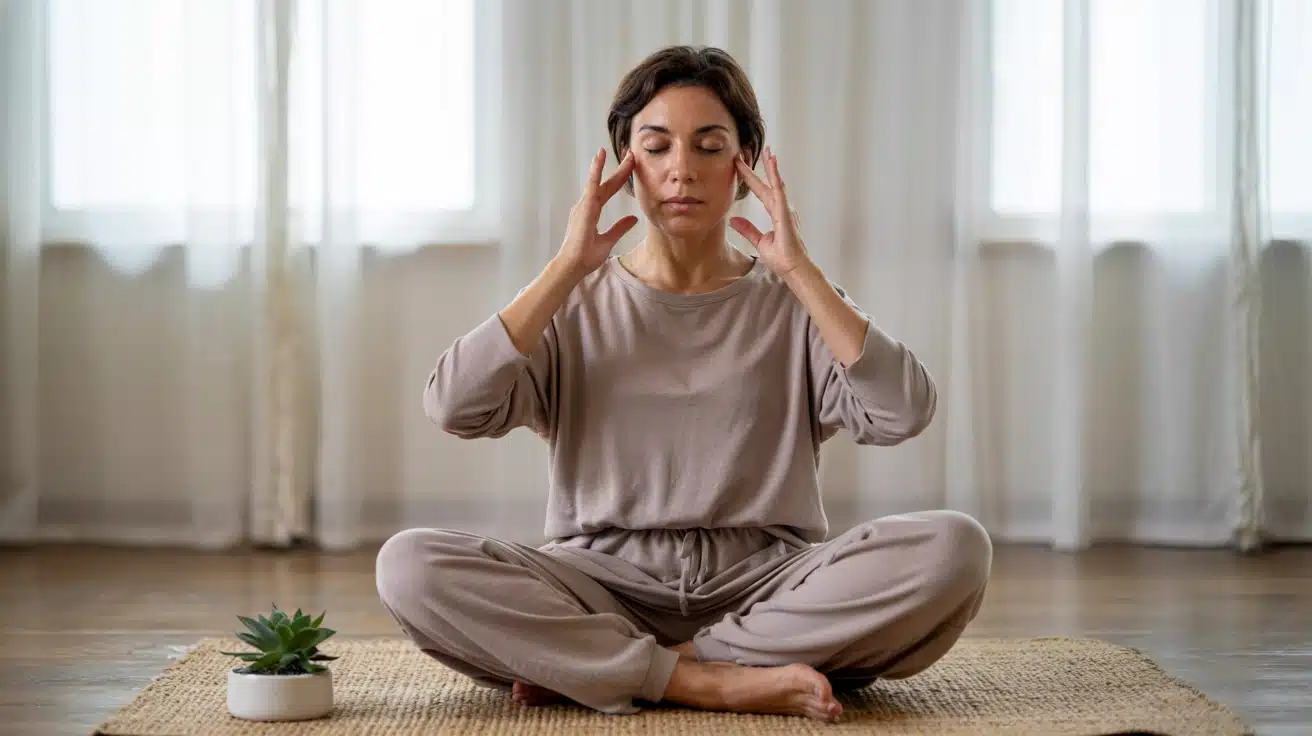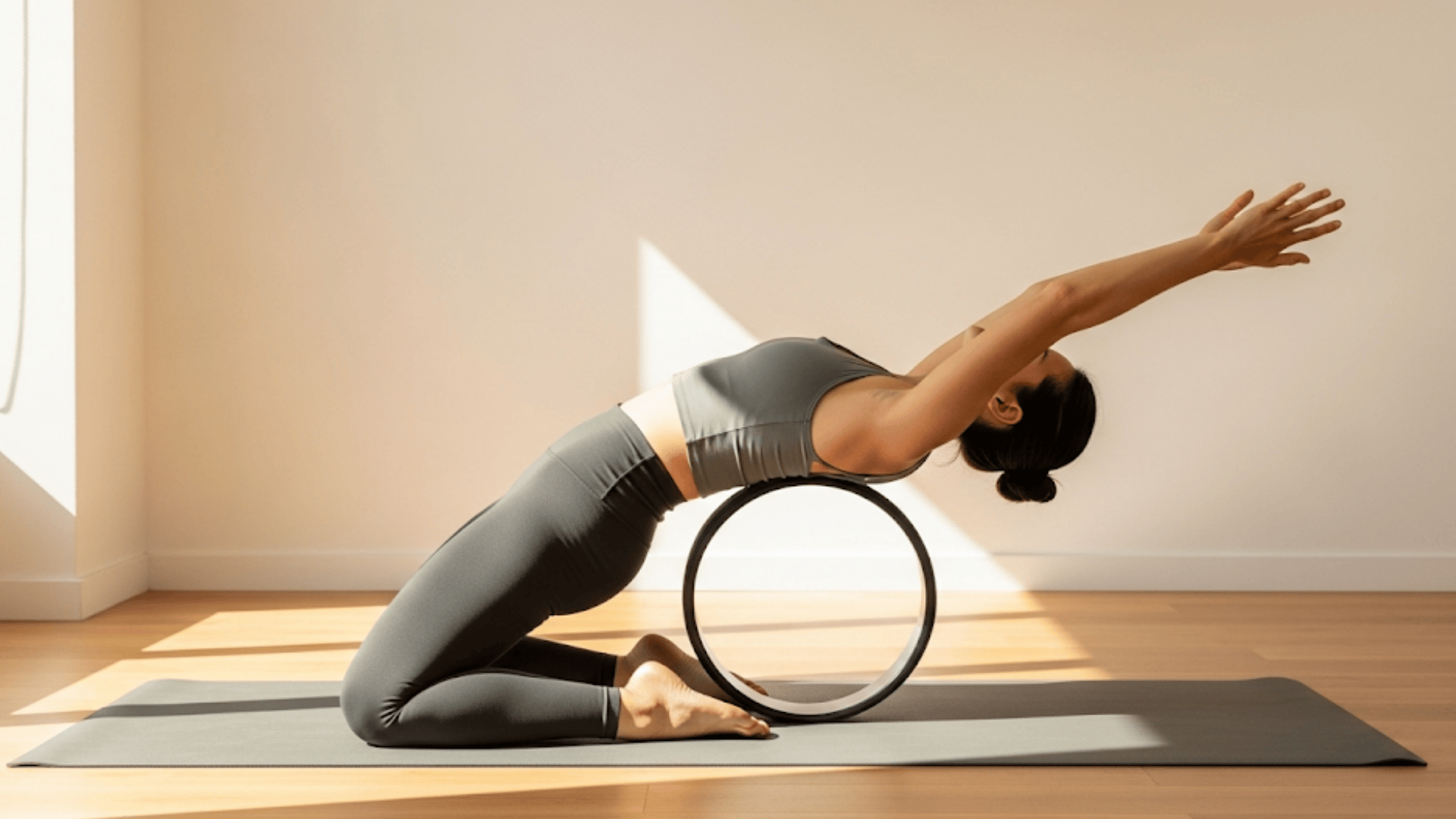Do you feel anxiety taking over your body with racing thoughts, tight muscles, and shallow breathing?
Millions of people struggle with anxiety that shows up as physical tension, making it hard to find real relief through mental techniques alone.
These body-based practices work directly with your nervous system to release tension and calm anxious feelings naturally.
Unlike traditional methods that focus only on thoughts, somatic exercises for anxiety address the physical roots of anxiety.
In this article, you’ll learn simple somatic exercises for anxiety that you can use anywhere. These practices will help you shift from fight-or-flight mode into calm, balanced states.
What Are Somatic Exercises for Anxiety?
Somatic exercises for anxiety are body-based practices used to regulate anxiety by focusing on internal physical sensations.
These methods help calm the nervous system, reduce chronic stress, and improve emotional regulation.
Unlike traditional approaches that work primarily with thoughts, they engage your body’s natural healing mechanisms to address the physical roots of anxious feelings.
These gentle techniques recognize that anxiety isn’t just a mental experience. It’s deeply connected to how your body holds tension, breathes, and responds to stress.
When you practice somatic exercises, you’re essentially teaching your nervous system to shift out of fight-or-flight mode and into a more balanced, calm state.
Benefits of Somatic Exercises for Anxiety
- Calms your nervous system and shifts you out of fight-or-flight mode
- Reduces physical tension held in muscles and joints
- Provides immediate relief during panic attacks or anxious moments
- Improves sleep quality and helps with insomnia
- Works anywhere without special equipment or quiet spaces
- Builds emotional resilience over time with regular practice
7 Somatic Exercises for Anxiety That Actually Work
The following seven somatic exercises for anxiety target your nervous system directly for lasting relief.
1. 4-7-8 Breathing Method
This somatic exercise for anxiety works by activating your parasympathetic nervous system through controlled breathing.
The technique slows your heart rate, promotes deep calm, and aids sleep by signaling safety to your body.
The extended exhale phase is particularly effective at shifting you out of anxious states, making it one of the most reliable somatic exercises for anxiety.
Follow these easy steps:
- Exhale completely through your mouth.
- Close your mouth and inhale quietly through your nose for 4 counts.
- Hold your breath for 7 counts.
- Exhale through your mouth for 8 counts, making a whooshing sound.
- This completes one cycle – repeat for 3-4 cycles.
2. Butterfly Hug
The butterfly hug is one of the most accessible somatic exercises for anxiety, using bilateral stimulation to integrate both sides of your brain while providing self-soothing comfort.
This technique calms the nervous system and reduces anxiety by creating a rhythmic, nurturing touch that mimics the sensation of being held.
You can practice this method anywhere, making it ideal for managing anxiety in social situations or at work.
Follow these easy steps:
- Cross your arms over your chest.
- Place your hands on your shoulders.
- Gently tap your shoulders alternately in a slow, rhythmic pattern.
- Continue for 30 seconds to several minutes.
- Adjust the speed and pressure to what feels most soothing for you.
3. Grounding Through the Five Senses
This grounding technique interrupts anxious thought patterns by redirecting your attention to physical sensations in your immediate environment.
It reconnects you with the present moment, reducing overwhelm and dissociation.
This somatic exercise for anxiety is particularly effective when your mind races with future worries or past concerns, helping to anchor you in the present moment.
Follow these easy steps:
- Identify 5 things you can see around you.
- Notice 4 things you can physically feel or touch.
- Listen for 3 things you can hear.
- Identify 2 things you can smell.
- Notice 1 thing you can taste.
- Take your time with each sense, focusing on the details of what you’re experiencing.
4. Body Scan
The body scan teaches you to develop a neutral relationship with physical sensations associated with anxiety.
This somatic exercise for anxiety relaxes the body, reduces tension, and enhances mindfulness by helping you observe without judgment.
As you practice regularly, you’ll become more skilled at recognizing where tension lives in your body and how to release it naturally.
Follow these easy steps:
- Lie down comfortably or sit in a chair.
- Start with your toes and slowly bring your awareness to each part of your body.
- Move upward through your feet, legs, torso, arms, and head.
- Notice any sensations without trying to change them.
- Simply observe warmth, coolness, tension, relaxation, or any other feelings that arise.
5. Pendulation
Pendulation helps you move fluidly between different sensations rather than getting stuck in anxiety states.
This somatic exercise for anxiety helps build nervous system flexibility and emotional balance by teaching your system to shift between states of activation and calm.
The technique prevents you from becoming overwhelmed by difficult sensations and builds resilience over time.
Follow these easy steps:
- Notice an area of your body that feels tense or uncomfortable.
- Observe this sensation briefly (about 30 seconds).
- Shift your attention to an area that feels neutral, comfortable, or pleasant.
- Focus on this comfortable area for about 30 seconds.
- Alternate your focus between these two areas.
- Notice how your body responds to moving between different sensations.
6. Titration
Titration allows you to work with anxiety gradually rather than being overwhelmed by it. This somatic exercise for anxiety processes difficult emotions in manageable doses, preventing emotional flooding.
The technique helps you build your capacity to handle stress over time by teaching you to approach uncomfortable sensations in small, digestible pieces.
Follow these easy steps:
- Notice an area of mild discomfort or anxiety in your body.
- Focus on just a tiny piece of the feeling, not the whole sensation.
- Observe this small sensation for a few seconds.
- Deliberately shift your attention to a neutral or safe area of your body.
- Return to the comfortable area whenever the discomfort feels too intense.
- Gradually build your tolerance for difficult sensations over time.
7. Resourcing
Resourcing helps you access your body’s natural capacity for calm and safety by connecting you with positive sensations and memories.
This somatic exercise for anxiety activates a sense of internal support and stability, providing an anchor during difficult moments.
The technique reminds your nervous system that safety and comfort are available, even during challenging times.
Follow these easy steps:
- Recall a memory, place, or person that feels genuinely safe, comforting, or empowering.
- This might be a peaceful location in nature, a loving relationship, or a moment when you felt strong.
- Bring this resource to mind clearly.
- Notice how your body responds to this positive memory.
- Observe sensations like warmth, relaxation, or a sense of expansion.
- Stay with these positive sensations for several minutes.
Somatic Exercises for Anxiety Video Class
Each somatic exercise for anxiety builds on the others to create a complete practice. This guided class demonstrates the breathing methods, body awareness, and grounding techniques covered in this article as a flowing sequence.
This 15-minute guided class demonstrates the techniques covered in this article in a complete, flowing sequence. Manuela Mitevova provides clear cues and modifications throughout the practice.
The Bottom Line
Your body holds the key to calming anxiety naturally. At the same time, your mind might race with worried thoughts, somatic exercises for anxiety work directly with your nervous system to create real, lasting change.
These gentle practices teach your body how to move from stress into safety without fighting against anxious feelings.
The beauty of somatic exercises for anxiety lies in their simplicity. You don’t need special equipment, quiet spaces, or hours of practice.
These techniques meet you where you are and work with your body’s natural healing abilities.
Start small with one technique that feels comfortable. Practice regularly, even for just a few minutes each day.
As you build this relationship with your body through these exercises, you’ll find that calm becomes more accessible.

